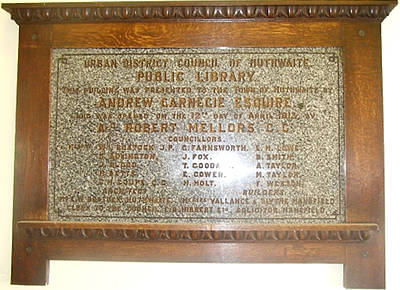Huthwaite Library

County libraries may be cross categorised as both educational or recreational centres. Long history behind this Free Public Library can reveal several updates far beyond its 1912 foundation stone.
Carnegie Free Public Library
Title stone above modernised doorway reflects funding was gained from philanthropic endeavours of Scottish born Andrew Carnegie.
 Credit must nonetheless be given Huthwaite Urban District Councillors, whom, during time when trying to assert Huthwaite with prospering town status, managed to take advantage of that immense generosity.
Credit must nonetheless be given Huthwaite Urban District Councillors, whom, during time when trying to assert Huthwaite with prospering town status, managed to take advantage of that immense generosity.
Choosing a prominent central site would proudly claim position adjacent offices they'd inherited from an earlier named Hucknall Huthwaite Council. Whilst also buying up land to far rear, cornering top their later developed Columbia Street, a compulsory purchase order was served to Shepperson for their old farm. Family were rehoused in Newcastle Street, where Mr John Boot claimed hearing of grandmothers grief.

For greater benefit of others, however, this shows a fine looking building predating any photographs. Its presented by John Knight, whom in Farnsborough, Hampshire, may well trace an influential genealogy stemming from Hucknall Huthwaite. The architect who penned out this proposed design was in fact his great uncle Ernest W Bostock. Family letters also disclosed how Ernest used this original to example his professional ability entering WWI. He sought and was duly awarded a Royal Engineers commission.

Year 1912 actually marked laying foundations to begin construction. An inside entrance plaque has since proudly shown ceremonial date of opening. An easier read accurate transcription better names all 1913 officials witnessing 12th April presentation to an ambitiously higher status titled Town of Huthwaite.
PUBLIC LIBRARY
The building was presented to the Town of Huthwaite by
ANDREW CARNEGIE ESQUIRE.
and was opened on the 12th day of April 1913, by
Ald ROBERT MELLORS C.C.
Councillors,
W Bostock J.P., G Farnsworth, E H Lowe, G Adlington,
J Fox, B Smith, J Blood, T Goodall, A Taylor, M Betts,
E Gower, M Taylor, C H Coupe C.C., H Holt, F Weston
Architect: E W Bostock, Huthwaite.
Builders: Vallance & Blythe, Mansfield.
Clerk to the Council: E B Hibbert Esq, Solicitor, Mansfield.
Fashionable iron railings bordering the premises initially invited a curvaceous entrance up central stone steps. A steeply descending pathway on either side found thoughtful design incorporated public toilets beneath. Left side served Gents and right side stepped down into the Ladies. Introducing those modern public facilities would be an additional benefit, but welcomed furthermore by the visitors provided with a spacious Lecture Hall.
The designated Lecture Hall filled out a large library basement level. Separate rear double door access was designed with storage rooms able to suitably host larger group bookings. Employing a caretaker ensured keep of the entire premises.
Early views along an informally named Bottoms shows a previously introduced tram service, while revealing how the Library had been proudly given a prominent Sutton Road position. Those adjacent Urban District offices would see out the Huthwaite Council when it was forcefully merged back under an enlarged Sutton-in-Ashfield Urban District Council authority. Their hopes to fully assert individual town status were then dashed before the higher Nottinghamshire County Council next took responsibility on for all its public libraries.



My comparable 2000 scene of an exposed structure comes long after clearing away all older unsanitary and unsafe dwellings. Its prime siting had minimised the width for this main through road before anyone really envisaged the volume of motor traffic seen today. Exiting a busier corner junction needs some blinded care, but an opened plot thereafter shares free visitor parking amidst other leisure amenities.
Far more demanding problem faced before entering this 21st century was whether a cost cutting county council could afford to keep less used smaller local libraries. After long neglect through nearly 75 years, Huthwaite luckily survived those closure threats to merit an indexed presentation of its later revamps.
23 Apr 04 by Gary Elliott Updated 18 Nov 18







